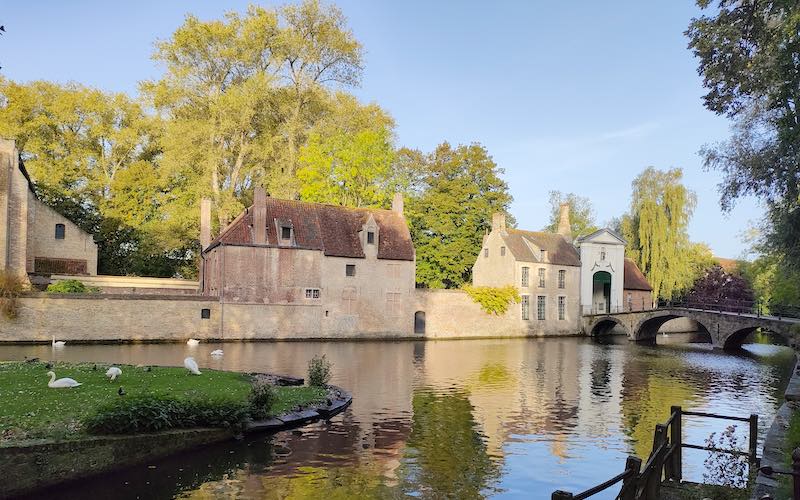I’m here to tell you that solo travel in Belgium is fun, easy and totally worth it! I’ve been travelling to Europe several times both solo and with friends or family. This year, I was inspired to travel to Belgium by a woman called Sarah who I met on a trip to Lisbon (her Instagram is @howaboutbelgium). I also fell in love with the idea of visiting Bruges from the movie ‘In Bruges’ (if you haven’t watched it before you travel to Belgium I recommend it!)
Disclosure: templeseeker.com is a participant in the Amazon Services LLC Associates Program and other affiliate advertising programs designed to provide a means for us to earn fees by linking to Amazon.co.uk, Get your Guide and other affiliated sites. Affiliate links may be used in this article on ‘solo travel in Belgium’, but they do not impact on the price that you pay and they do help me to get this information to you for free.
When is the best time to visit Belgium?
I visited in early October and it was truly perfect. There was no rain and it was still warm enough to walk around in leggings and T-shirts.
Personally, I would avoid Belgium in the summer months of July and August as they would be too hot. If you go in the summer or the shoulder season (the months of May, June, September, October) take a refillable water bottle and carry it with you so that you don’t dehydrate.
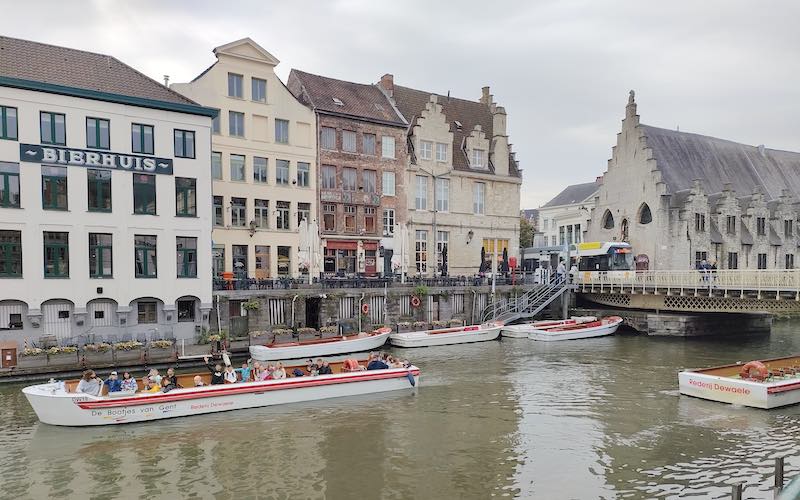
Photography copyright: All the images in this blog are original photography by Amy Green and are property of @templeseeker (unless otherwise stated). Please do not use these without permission or without giving credit. If you would like to use any of these images please email: amy@templeseeker.com for permission.
What did I get up to on my solo trip to Belgium?
So what did I get up to on my solo trip to Belgium? I explored the unexpected street art of Charleroi. I embarrassed myself by falling up some train steps on the way from Charleroi to Brussels. I drank copious amounts of Belgian beer and ate plenty of Belgian chocolate in Ghent (nope, this is not a place for calorie counting I’m afraid!) I met a South Korean policeman in a youth hostel in Brussels and then found the trio of peeing statues. Oh, and I followed the footsteps of my favourite film characters from ‘In Bruges’ including climbing the belfry and a visit to the Basilica of the Holy Blood.
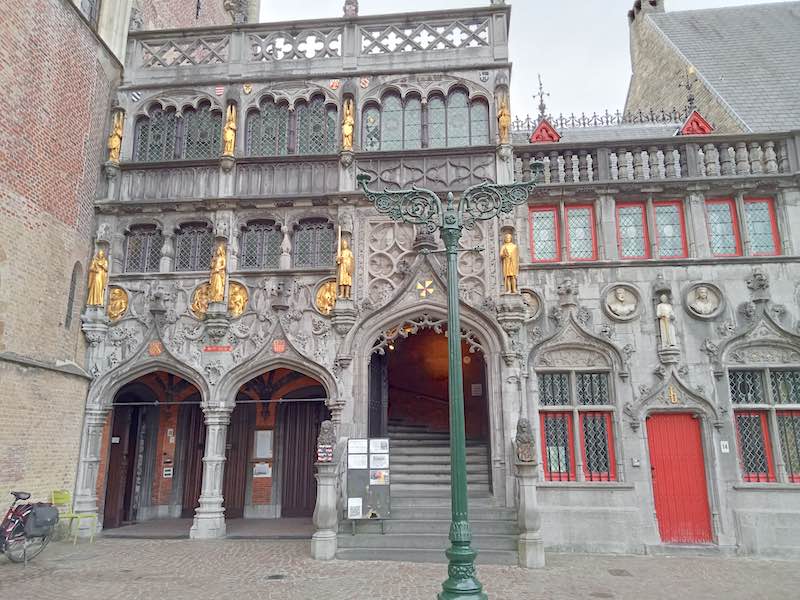
Belgium Solo Female Travel – Is it safe?
I honestly felt extremely safe as a solo female traveller in Belgium. The only thing that concerned me were the pickpockets in Brussels. Our guide in Brussels mentioned that there are a few, and advised us to carry our bags or backpacks on our front rather than the back. If you feel something move your backpack turn around VERY swiftly just incase.
Brussels, being the capital city, had a few bits of deprivation and poverty. Not a lot, but more noticeable than in the other cities such as Bruges or Ghent. For example, I did see a drunk homeless man and some of the alleys and around Brussels Midi stunk of pee at times. These sights (and smells!) you don’t really get in Bruges, Ghent or Antwerp. But as with most capital cities, it comes with the territory.
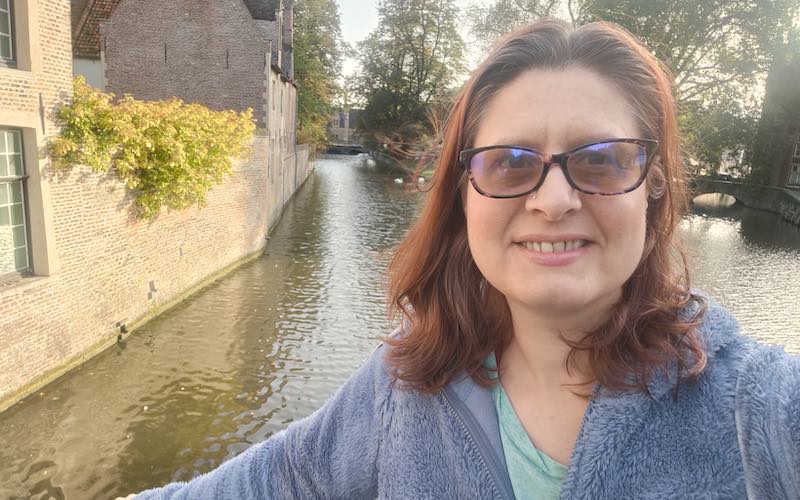
I would recommend that if you are staying in hostels that you take a code or key padlock, because most hostels in Belgium will have lockable chests or lockers but they don’t supply the padlocks to go with them. You are expected to bring your own.
My Solo Travel in Belgium itinerary
I flew from Manchester to Brussels Charleroi with Ryanair. Charleroi was slightly out of the centre of Brussels so I took a day to explore the things to do in Charleroi.

My itinerary was 9 days in total – 3 days each in Bruges, Ghent and Brussels. This was the perfect itinerary with the exact amount of time that suited my pace of travel. With only an hour (approx) between each city and more than enough days to spend, I didn’t feel rushed one bit. If you had a few more days or wanted to speed things up a bit, you can see Antwerp and Leuven as day trips from Brussels. You might like to read this itinerary for one week in Belgium.
Many people try to do Bruges or Ghent as day trips, but I feel that they warrant much more! As I say, I travelled all around Belgium for 10 days and felt extremely safe and comfortable.

The Best Cities to visit in Belgium
- Bruges – This quaint medieval city is one of the most picturesque in Europe. Yes, it’s busy and touristy, but don’t miss it! Spend at least two days there, but it is possible to do Bruges as a day trip if you are pushed for time. Don’t miss the Belfry, Markt, The Burg (and Chapel of the Holy Blood), Saint Salvadors Cathedral and Church of Our Lady.
- Ghent – One of the most prosperous cities in Europe between 11th-16th Centuries. This has resulted in some phenomenal medieval architecture including Saint Nicholas Church, the Belfry and Bavo Cathedral. Don’t miss St. Michaels Bridge, the old meat and fish markets, Friday Market Square and the old houses on Kranlei.
- Brussels – The vibrant capital of Brussels is buzzing, yet smaller and more manageable than Paris and London. Don’t miss La Bourse, the Galleries, the Royal Palace and Grand Place. Also take some time to explore some of the beautiful local areas including St. Catherines and Sablon.
- Antwerp – Arrive by train to see the beautiful Antwerp Station with an Art Nouveaux ceiling. Don’t miss Grote Markt, Cathedral of Our Lady and Groenplaats. If you’re interested in art then visit the Rubenshuis. Spend a couple of days there if you can, but if not Antwerp is doable as a day trip from Brussels.
- Leuven – A cute little city to the East of Brussels, Leuven makes an excellent day trip. It has a stunning central square – it’s 15th-century town hall, with its tall gothic spires. Also don’t miss Oude Markt and St. Peter’s Church, which houses a “Last Supper” by the Flemish Primitive painter Dieric Bout.
- Ypres – Ypres is a small town in Western Flanders and it is a good place to base yourself if you are interested in doing some of the WW1 tours as it is surrounded by the Ypres Salient battlefields. Also, don’t miss the main square and Sint-Maartenskathedraal (St. Martin’s Cathedral). Although much of Ypres was destroyed in the war, it has been lovingly restored.
As well as these main cities, if you have a bit more time to spend and enjoy relaxing slow travel, then you could consider some of the smaller destinations in Belgium including Mons, Mechelen and Dinant.
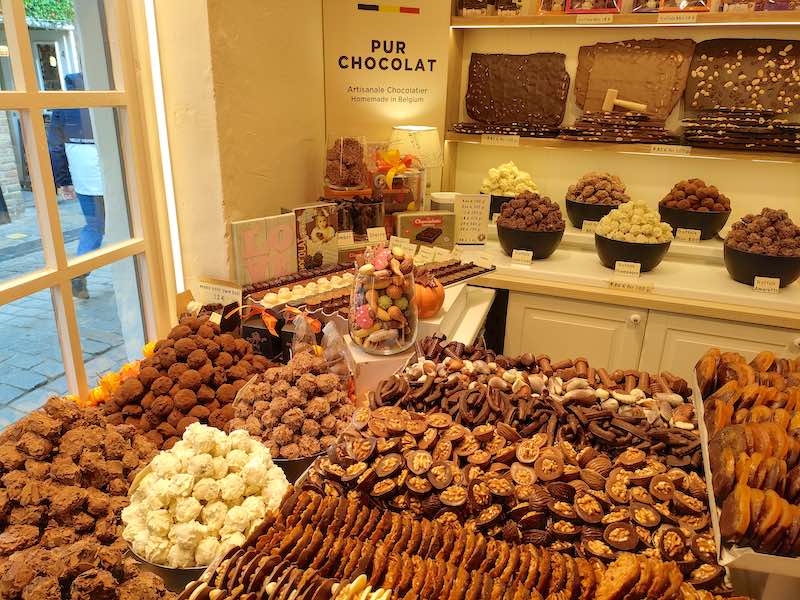
Transport in Belgium – Getting there and around
The two main airports are Brussels and Charleroi. If you have a day to spare before your flight then you might want to check out these things to do in Charleroi.
Buses – For the local buses from Charleroi airport take the A1 from Charleroi to Charleroi Central Gare for onward travel by train. Buy your TUC tickets at the machine.
For airport transport you can use flibco.com and book your bus transfers online. Flibco buses run from Charleroi to the main cities including Brussels, Bruges and Antwerp. The line from Charleroi to Brussels doesn’t sell you a ticket for a specific time, but instead it’s the date you need and they run every 20 minutes. Make sure that you book the right date because there is no way to change it.
Trains – The trains in Belgium are fast, comfortable and easy! You can buy tickets from the machines in the station which are in English, Dutch and French. I took the train between Bruges, Ghent and Brussels and it was really easy. Change in Brussels-Midi for Bruges. You can also buy train tickets for Belgium in advance on the official website here (the website is available in English, French, Dutch and German).
Electric scooters and bikes – If you are in one of the main cities and want a more efficient way of covering ground than on foot, consider cycling or even renting one of the electric scooters. Most Belgian cities are quite flat and have good cycle lanes.

Languages can be confusing in Belgium!
Belgium has three official languages – Flemish (Dutch), French and German. What I struggled with, was learning when to make the switch! Bruges, Ghent and other destinations in Flanders are Flemish – Dutch speaking with a bit of an accent. The South of Belgium and Brussels tend to be mainly French speaking, although most people are bilingual with French and Dutch. To make it even more confusing, there are small German speaking communities in Belgium as well.
This takes some getting used to, but when you are there, you will tend to learn what is mainly spoken in the city or community that you are in. And, you will be pleased to know that English is also widely spoken in Belgium, especially by those in the hospitality industry. So in hotels, restaurants and some bars, you will be ok in English. It’s advisable to learn a bit of French and Dutch before you go. I recommend the Duolingo app for this – it makes learning languages on your smartphone both easy and fun!
All I’m saying is it’s a good job I did French GCSE!

Top tips for Solo Travel in Belgium
- Order transport from airports via www.flibco.com – the Flibco bus to and from Charleroi doesn’t allow you to pick your time. It is an open ticket available on any bus for just over 24 hours for the day of booking (Midnight-4am the following morning)
- Learn some basic French and Dutch, and learn when to switch them! The south is French speaking but the North West is Dutch.
- Take plenty of Euros and also your VISA and Mastercard or American Express (all my UK credit and debit cards worked in Belgium)
- Get rid of or your small 1c and 2c coppers as they don’t accept them in many places in Belgium. The smallest they would accept from me was 5c.
- Have a few 50c coins available, because most toilets charge this (especially in Bruges).
- Take one of the ‘free walking tours’ in each city that you visit to learn about the history and culture, and to get insider tips on where to eat and drink.
- Tip your ‘free tour guides’ but no need to tip in restaurants
- Take a padlock if you are staying in Youth Hostels to securely lock your stuff away.
- Wear your backpack on your front in Brussels and keep your phone and purse close and secure (to avoid pickpockets).
- When choosing a good restaurant, AVOID the ones with pictures of food and waiters standing on the doorway trying to get you in!
- For onward travel to other European cities I recommend Flixbus.

Where to stay – My Hostels in Belgium
- Bruges – Hostel Lybeer (clean rooms, good communal area and great beer tasting events). They also do private rooms just for two.
- Ghent – Hostel Uppelink on St Michaels Bridge (beautiful view, fast wi-fi and walking tours start from right outside the hostel.
- Brussels – Latroupe Hostel (modern and vibrant Brussels hostel with great breakfast, bar and social areas)
Highlights of Belgium at a Glance
And now, for a quick summary of what not to miss in Belgium….
- Chapel of the Holy Blood and the Belfry of Bruges.
- Grand Place and Royal Palace Brussels.
- St Michaels Bridge, riverside and Bavo Cathedral, Ghent.
- WW1 tours of Ypres.
- Leuven’s Gothic Town Hall.
- Belgian breweries (you can find them in all main towns and cities!)
What to pack for Solo Travel in Belgium
- Good sturdy walking boots – I like my Karrimor Bodmin Weatherlite.
- Rain jacket – mine is Regatta (good make, comfortable and practical).
- EUROS in money and VISA and/or MASTERCARD
- Refillable SIGG water bottle (empty it before airport security and refill the other side!)
- Comfortable clothing – leggings, walking trousers, cycling shorts and T-shirts.
- Padlock for lockers in hostels – this will help to keep your belongings secured.
- Lonely Planet Belgium and Luxembourg – it’s nice to have something physical to read for when you don’t have internet.

Further Reading on Solo Travel in Belgium
I hope that you enjoyed my article on Solo travel in Belgium. If you would like to read more, then check out these articles which might be of interest to you…
- Things to do in Ghent
- Is Ghent worth Visiting?
- Best food in Ghent
- Is Bruges worth visiting?
- Churches in Bruges

